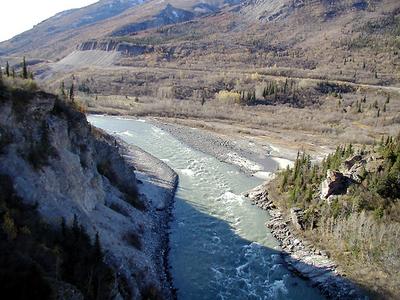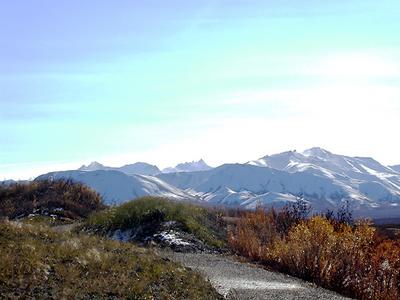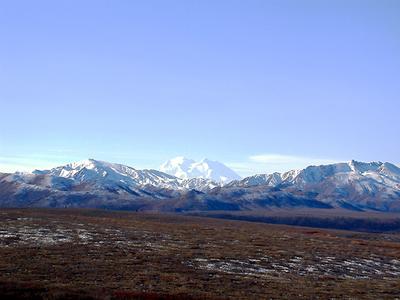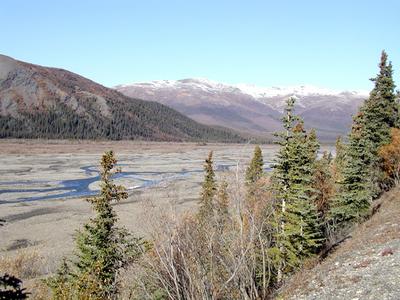22 September, 2002
9/22/02
Southward to Denali
Another early morning had us on the road traveling southward from Fairbanks. The purpose of our excursion was to find stands of Birch trees that still had some significant leaf cover. Nearly all of the native Birches in the Fairbanks area have lost their leaves, and consequently, lost their Stinkbugs as well. Our initial drive out if the valley where Fairbanks lies gave us some spectacular views of the area. What is interesting to me is just how little of Fairbanks you can see from the overlook areas. Most of the homes in Fairbanks are nestled amongst wooded areas and were screened from our view. The only major human structure that stands out is the Fairbanks airport. It also helps that Fairbanks is a relatively small city set in a very large valley area.
The initial part of our drive did not give us much hope of finding the needed Birch trees. We found several stands still with leaves, but the branches were far too high to reach. As we continued to drive south it was obvious that it was also windier outside of the Fairbanks valley area. Not only were the Birches without leaves, but so were the Aspens and the Poplars. We passed the town of Nenana which sits on the banks of the Tanana River. Just a short while later we passed over the Nenana River for the first time. I cannot seem to find an answer for why the town of Nenana is on the Tanana River rather than the Nenana. I leave it as one of the great Alaskan mysteries.
We crossed over the Nenana River several more times as it wound its way north and much more quickly that I expected we entered the borough of Denali (Alaska is divided into areas called boroughs rather than counties). I was also surprised that upon nearing the Denali Borough that I did not see a chain of large mountains. As the road passes south, it moves into a lowland area where the view of the mountains is obscured by lower hills. Before long however, the northern edge of the Alaskan Range Mountains began to appear. The Alaskan Range runs from east to west across the state and is in many ways similar in structure to the Himalayas. From above, chain after chain of mountains line up to provide a rippled look to the landscape. We passed through the Nenana River gorge, which is of note not because of any impressive depth or width but because of the force of the wind that passes through the gorge. Anyone walking on the gorge bridge is required to lean into the wind in order to make any progress.
Shortly past the Nenana River gorge, we arrived at the entrance to Denali National Park and Preserve. The park and preserve cover approximately 6 million acres of land that include mostly sub-arctic taiga and alpine tundra ecosystems. The park is home to an amazing variety of wildlife and is one of the most popular tourist destinations in Alaska.
Denali is a limited access park, which means that normally you can drive into the park only a few miles. At the end of the paved park road is a large parking area where you can leave your car and board a park service bus to see the more interior parts of the park. We were fortunate enough to arrive at the park at a time when there are so few visitors that the buses are no longer offered. Instead, park officials open additional parts of the road so that visitors can travel as much as 30 miles into the park. The additional road gave us some very nice views of Mt. McKinley (also known as Denali). Mt. McKinley is the tallest mountain in North America at 20, 320 feet and is a very obvious and very impressive point on the landscape when driving through central Alaska.
We were treated to views of much of the Denali wildlife. We saw many different species of birds, several moose, and beaver in a nicely sized beaver pond and for the first time since I have been in Alaska, I had the opportunity to see a bear. At the end of the accessibly road was an area overlooking a very wide, dry streambed and on the opposite side of the streambed was a young male grizzly bear foraging for roots and seeds. While still some distance away, he was obviously large and was very impressive through a pair of binoculars. We were able to watch him forage for more than an hour before he moved back into the trees.
With the bear gone and as far along the park road we could go, we turned around and headed for home. Though we did not find but a handful of Stinkbugs, the trip seemed more than satisfying anyway.

This is view down into the valley where the city of Fairbanks is located.

This is a view southward through the Nenana River Gorge.

Winter is encroaching on Alaska. Here in the mountains this pond has a thin skim of ice already on its surface.

Beaver are common to Alaska. This Beaver pond has been maintained by a beaver family for many years.

This is just the very northernmost line of the Alaskan Range Mountains.

Above all of the other mountains rises Mt. Mckinley.

This riverbed is mostly dry right now but in the spring it is covered with water it is named Teklanika River

Across the riverbed is a foraging Grizzly Bear. I have tried to make the photo as clear as possible without a telephoto lens.
Contact the TEA in the field at
.
If you cannot connect through your browser, copy the
TEA's e-mail address in the "To:" line of
your favorite e-mail package.
|
